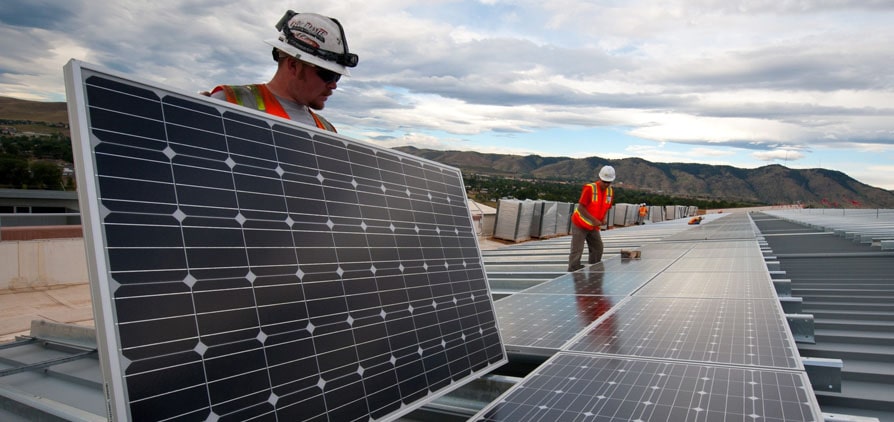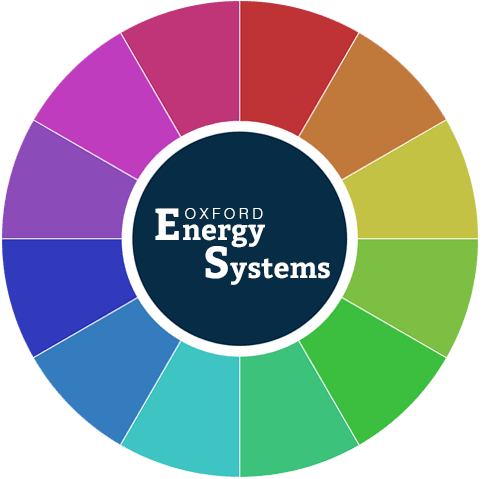Solar
Solar is the only renewable energy source which could, in principle, easily meet all the world’s energy needs. With 15% efficiency (already available from Photovoltaic (PV) and Concentrated Solar Power (CSP)), 0.5% of the world’s land surface would (with average irradiance) provide 20 terawatts of electricity – more than current total primary energy use.
The contribution of solar, which provided 1.3% of the world’s electricity in 2016, is increasing very rapidly (in 2016 it was 29.6% greater than in 2015, and nearly ten times more than in 2010). This rapid growth is set to continue, driven by the rapidly falling cost of PV. According to Bloomberg’s New Energy Outlook 2017 (NEO), installed capacity for utility [small] scale solar PV could increase from 3% [2%] of the world’s total generating capacity of 6,719 GW in 2016 to 22% [10%] of a total of 12,879 GW in 2040. CSP (which contributed some 5% of total solar power in 2015) is also increasing rapidly, and according to the International Energy Agency’s New Policy Scenario (NPS) capacity will increase from 10 GW in 2014 to 76 GW in 2040.
In 2016 the International Renewable ENergy Agency (IRENA) reported that the global average Levelised Cost Of Electricity generated by PV was $130/MWh in 2015 (compared to the average LCOE for gas and coal in the range $(50-100)/MWh). IRENA believes that it could fall by 59% by 2025. However, Bloomberg’s NEO reports average LCOE’s in the range $55-75/MWh in 2016 in the USA, India, Italy, Mexico and China, which it expects to fall to $20-25 in 2040.
Continued research can further reduce PV generation costs. Large scale deployment will, however, also require improvements in electricity networks and/or energy storage, and/or greater demand response, which will add to costs. Designing a market that provides incentives that will produce the optimal mixture of these measures is an enormous challenge, which the Oxford Martin Programme on Integrating Renewable Energy (see accompanying case study) is addressing.
Research in Oxford

Photovoltaic
Silicon Photovoltaics
Over 80% of Photovoltaic (PV) electricity is based on crystalline silicon. These current solar cells are relatively energy intensive, wafer based devices sawn from crystal ingots. Oxford material scientists are developing techniques to reduce costs and improve the performance of these cells, for instance by developing new ways to reduce recombination at silicon surfaces, and by more effectively controlling the effect of impurities so that cells can be made more electrically efficient or from cheap and relatively dirty material.
Researchers are studying two main types of defects: surface defects limit the performance of the most efficient commercial solar cells while bulk defects are present in high concentrations in less expensive feedstocks and reduce the efficiency of devices using such materials. Oxford materials has developed world-leading surface passivation techniques for high efficiency devices which would allow the fabrication of devices with efficiencies approaching 26 %. Work is also proceeding on gettering and passivation of bulk defects to produce the most cost effective devices on low cost silicon materials.
Perovskite Solar Cells
330nm-thick film of organometal halide perovskite fabricated on a glass sheet by vapour deposition.
A recent advance from the Oxford Physics department is the development of solar cells based on the material class of Perovskites. Efficiencies have been driven up to 20% in a remarkably short period of time using a simple cell architecture (see NREL chart and case study on Perovskites). This work is being commercialised by Oxford Photovoltaics (an Isis Innovation spin out company) which is planning to produce attractively coloured and semi-transparent glass, which works as a solar cell and could be integrated into the facades of buildings and windows.
Organic and Hybrid Solar Cells
Dye-sensitized solar cells, a hybrid solar cell technology, mimic natural photosynthesis. In contrast to conventional solar PV, ‘light harvesting’ and ‘charge separation’ take place in different (adjacent) materials, the former in an organic semiconducting dye, and the latter on the surface of a nano-crystalline film of titanium dioxide. Oxford academics aim to better understand photosynthetic processes and to design synthetic systems with ‘biomimetic’ absorbers, which mimic the performance of biological systems. This work is key to advancing dye-sensitised cell efficiency. Thus, Oxford physicists and chemists play a leading role in jointly developing absorber materials and architectures for more efficient organic and hybrid solar cells.
Dye molecules in solution excited by laser light
Oxford physicists and material scientists also develop manufacturing processes for new organic PV materials and devices. Roll-to-roll methods by which these materials can be deposited on flexible polymer foils are being studied and developed, with the potential to dramatically increase process speeds and reduce device costs.
Oxford material scientists are working on ways to reduce the cost of manufacturing robust non-toxic metal oxide based PV cells, which could emerge as another new thin film technology.
Advanced PV concepts
To further improve on the efficiencies of single junction thin film and crystalline technologies, Oxford material scientists investigate third generation photovoltaics. Technologies include multi-junction devices and newer quantum technologies such as hot-carriers and multi-exciton generation. Work is also underway on quantum dot photovoltaic devices produced by colloidal synthesis and molecular beam epitaxy, while Oxford physicists have worked on crystalline thermo-photovolatic cells which convert thermal radiation from very hot bodies directly into electricity.
Oxford mathematicians, chemists and material scientists support this work with first-principle calculations of the electronic structure of PV materials; the development of theoretical models (see case study) of the fundamental processes of light capture, and energy and charge transport; and modelling energy and charge transport in PV devices.
Artificial photosynthesis
Oxford chemists are among a growing number of scientists pioneering Artificial Photosynthesis (Solar Fuels), in which sunlight is used to produce hydrogen from water or reduced carbon compounds from CO2 using similar principles to those used by green plants. This requires a harvesting material (chlorophyll in plants) that uses light to separate charges (electrons and holes), and two catalysts (enzymes in natural systems) – one uses the electrons to convert water into hydrogen (or a concentrated source of CO2 into CO or formate), the other quenches the holes by converting water into oxygen. The challenges are to ensure that the catalyst captures all the electrons it needs to complete the chemical conversion without charges being lost, and endure robustness and scalability. Enzymes are the most efficient of catalysts, and Oxford chemists are currently using enzymes linked to suitable semiconductors to establish the principles for efficient electron capture and high reaction rates that should provide the design principles for future non-biological systems. See case study on artificial photosynthesis.
Concentrated Solar Power (CSP)
Concentrating sunlight improves the potential efficiency of both thermal and photovoltaic systems. Oxford physicists and engineers have developed a novel system for concentrating sunlight (for which patents have been filed) based on successive reflections from two mirrors, which (in contrast to the single mirror usually used) have very simple shapes that are easy to manufacture, transport and erect. On a small scale this system could be used to focus light on PV cells, thereby greatly enhancing the electricity that a given area of cells can produce. On a larger scale it could be used to produce electricity by driving a novel Stirling engine that Oxford physicists and engineers are developing, which could be fed with heat from burning biomass when the sun is not shining. Currently the primary objective is to use the two mirror systems as a simple and cheap source of renewable energy for cooking, which could help to reduce the 1.5 million deaths (mainly of children and women in developing countries) caused every year by ingesting smoke particles generated by indoor cooking. See solar cooker case study.
Reports
Roadmap on established and emerging photovoltaics for sustainable energy conversion


